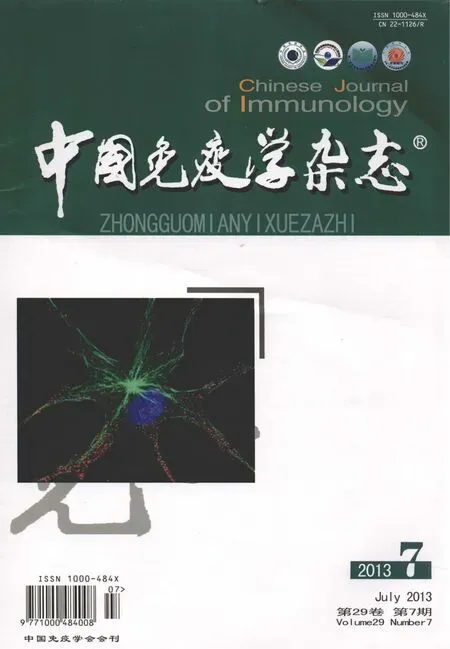黑色素瘤相关抗原MAGE-A2:肿瘤免疫治疗新靶点①
姚胜忠 谢 莎 肖燕子 闭水清 谢小薰 肖绍文
(广西医科大学第一附属医院神经外科,南宁530021)
癌-睾丸抗原(Cancer-Testis Antigen,CTA)是一类广谱的肿瘤特异性抗原。CTA能在多种肿瘤组织中广泛表达,而在正常组织(除胎盘和睾丸)中几乎不表达,并且在一些肿瘤患者体内可引起免疫反应。基于这些特性,CTA已成为肿瘤免疫治疗研究的热点靶抗原之一,其中一些 CTA如 MAGEA3、NY-ESO-1已进入临床试验阶段,并在一些肿瘤的治疗中收到较好的疗效[1,2]。黑色素瘤相关抗原(Melanoma-associated Antigen,MAGE)是CTA家族的重要成员,迄今为止,已鉴定出MAGE家族多个亚家族,其中MAGE-A亚家族包含13个高度同源的基因,依次命名为MAGEA1—A12;MAGE家族成员最大特征是其氨基酸序列存在一个MAGE同源结构域 (MAGE Homology Domain,MHD)。MAGEA2是MAGE-A亚家族的重要成员之一,研究人员对其潜在功能的研究以及其在临床中的应用不断深入,现就MAGE-A2基因、mRNA的表达、免疫原性、表达机理和生物学功能方面进行综述。
1MAGE-A2基因结构
MAGE-A2 又称为 MAGE2,MGC131923,根据MAGE-A2在CTA家族中的排名又命名为CT1.2(http://www.CTA.lncc.br/)。De等[3]于 1994 年通过T细胞抗原表位克隆的方法从人类黑色素细胞中分离并鉴定出MAGE-A2,mage-a2基因定位于染色体 Xq28,基因全长3 977 bp,mRNA长1 979 bp,包含3个外显子,开放阅读框位于第3个外显子,编码蛋白由314个氨基酸组成。
2MAGE-A2表达
研究人员通过RT-PCR和寡核苷酸微矩阵技术,对成年人各种正常组织及20周以上胚胎组织进行检测,除睾丸、胎儿及成人角蛋白细胞外,均未能检测到 MAGE-A2 mRNA[3-7],这表明 MAGE-A2 mRNA在正常组织中的表达具有明显的限制性。
MAGE-A2 mRNA分别在多种组织类型肿瘤中存在表达。由于MAGE-A2是在黑色素瘤细胞中发现,因此研究人员检测了大量黑色素瘤组织样品,证实了MAGE-A2 mRNA在黑色素瘤中的高表达,但在转移瘤和原位瘤中MAGE-A2 mRNA表达有一定差异,转移瘤表达率为70%(101/145),而原位瘤表达率为41%(41/100),在良性黑素细胞痣及发育异常痣中均未检测到 MAGE-A2 mRNA[8-12]。在脑肿瘤中,MAGE-A2 mRNA尤其以小儿脑瘤中表达多见,如在小儿室管膜瘤(8/14,57%)、小儿多形性恶性胶质瘤(1/9,11%)、小儿成神经管细胞瘤(9/15,60%),其在成人多形性恶性胶质瘤(1/20,5%)亦有表达[13,14]。MAGE-A2 mRNA 在肝癌中的表达有一定特点,在分化良好的肝癌组织中不表达,而在低分化及中等分化肝癌组织中有表达[15,16]。另外,在各种类型肺癌中均能检测到MAGE-A2 mRNA,如腺癌(4/35,11%)、鳞癌(3/14,21%)、小细胞癌(2/3,67%)及非小细胞肺癌(13/46,28%)[17,18]。此外,在浆液性卵巢腺癌(4/19,21%),卵黄囊瘤(?,25%)和骨肉瘤(23/28,82%)中也检测到MAGEA2 mRNA[19,20]。
除了肿瘤的临床标本外,在乳腺癌、结肠癌、胃癌、白血病、肺癌、黑色素瘤、黑色素瘤干细胞、畸胎瘤、口腔鳞状细胞癌、卵巢癌、前列腺癌、横状肌肉瘤、甲状腺癌等多种细胞株也检测到MAGE-A2 mRNA[4,5,21-28]。
3MAGE-A2的免疫原性
目前已有报道MAGE-A2引起细胞免疫[29],以下为已鉴定出的MAGE-A2抗原表位。
MAGE-A2蛋白在细胞浆内可被降解为短肽(多为九肽或十肽),在与HLA分子结合后,被递呈至细胞膜上为 CTL所识别,并诱导细胞免疫应答[30-34]。Akiyama 等[35]联合 MAGE-A2157-166肽段与其他黑色素瘤相关抗原肽段如MAGE-1、3制备多重黑素瘤相关抗原负载的DC疫苗,在9位转移性黑色素瘤患者腹股沟皮下进行注射。除短暂的肝脏异常外,该疫苗对患者无明显全身反应;9位患者中有6位患者可检测到超过2种黑色素瘤相关抗原的CTL,而患者1和6展示了显著的肿瘤退化现象,尤其在患者1体内,肺黑色素瘤出现明显退化。与注射疫苗前相比,5个患者体内Th1比例更高,3个患者对于复合疫苗显示出明显的迟发型变态反应。最后,研究组对疫苗注射后的患者临床反应进行检测,分别从PD(Progressive disease,疾病进展)、SD(Stable disease,疾病稳定)、PR(Partial response,部分缓解)、CR(Complete response,完全缓解)方面进行观察,在患者1体内,黑色素瘤在肺癌中的转移灶及肺门淋巴结尺寸明显减小,并且随着疫苗注射肺门淋巴结最后几乎完全消失。注射疫苗后,患者1、2、6有明显的CTL应答反应,且伴随明显的CTL增加,而患者4、5、7无CTL应答反应,且除患者7外其他均无明显的CTL增加。上述研究显示出负载DC的黑色素瘤复合疫苗确实在转移性黑色素瘤体内有一定作用,且其临床反应也显示出较强的抑制作用,但在所选的患者中,出现明显异质性,这可能与患者个体异质性有关,目前还不清楚其具体机制。
4MAGE-A2的表达机理

表1 MAGE-A2抗原表位Tab.1 MAGE-A2 Epitopes
Shichijo等[36]首先发现通过甲基化转移酶抑制剂DAC(5-Aza-CdR),可诱导淋巴细胞性白血病的肿瘤细胞和T细胞系(经植物血凝素/白细胞介素-2刺激)和B细胞系(EB病毒感染)表达MAGE-A2。随后,Sigalotti等[37]分析56名皮肤黑色素瘤患者肿瘤组织中MAGE-A2的表达与其启动子区域甲基化状态,结果发现在MAGE-A2阳性的肿瘤组织中,其启动子区域为非甲基化状态,而在MAGE-A2阴性的肿瘤组织中,其启动子区域为甲基化。用DAC处理MAGE-A2阴性的黑色素瘤细胞株后,可诱导MAGE-A2表达。为了进一步验证甲基化对MAGEA2表达调控,他们还构建MAGE-A2启动子的报告基因质粒,将该质粒进行甲基化处理后,分别将经甲基化处理和未经甲基化处理的质粒转入黑色素瘤细胞株中,结果发现未经甲基化处理的质粒显示报告基因活性,这说明了启动子甲基化对于MAGE-A2的转录起调控作用。Takahito等[28]发现在低表达MAGE-A2的前列腺癌细胞株中,用DAC处理可上调MAGE-A2表达。另一研究报道也显示用DAC处理后的白血病、肝癌、前列腺癌、乳腺癌和结肠癌细胞株,MAGE-A2表达明显上调,而这种现象仅发现在MAGE-A2低表达的细胞株[38];另外,该研究还发现乙酰化转移酶TSA(Trichostatin A,曲古抑菌素A)能协同DAC上调MAGE-A2表达,联合应用DAC和TSA处理细胞株可使MAGE-A2上调率更高,而单独使用TSA仅微弱上调MAGE-A2的表达;为了功能性地检测DNA去甲基化和组蛋白乙酰化对启动子活性的影响,进一步通过构建含报告基因的MAGE-A2启动子质粒,将其甲基化处理后,分别将经甲基化处理和未经甲基化处理的质粒转染不表达MAGE-A2的乳腺癌细胞MCF-7,结果发现与非甲基化质粒相比,转染甲基化质粒的组别其启动子活性下降明显,然而,转染甲基化质粒的细胞经TSA处理后,启动子活性上升,而转染非甲基化质粒的细胞经TSA处理后,启动子活性上升明显,这些结果说明MAGE-A2的转录不但受甲基化的调控,而且也与乙酰化有关。然而,在表达MAGE-A2的卵巢癌细胞株中,DAC处理细胞却下调MAGE-A2表达,这可能与不同细胞对DAC的反应不同有关[39]。
甲基化CpG结合域蛋白(Methyl-CpG binding domain proteins,MBD)是一类结合在甲基化的CpG位点起转录抑制作用的蛋白,为了深入探讨甲基化对 MAGE-A2 表达的调控,Wischnewski等[40]研究了目前较热门的几种 MBD,如 MBD1、MBD2a和MeCP2,电泳迁移率检测结果显示MBD1与甲基化和非甲基化的MAGE-A2启动子都有亲和力,而使用针对MBD1和MeCP2的染色质免疫沉淀技术后,结果显示MAGE-A2基因表达上调,而 MeCP2对MAGE-A2亲和力更高,这表明MBD1和MeCP2可抑制MAGE-A2启动子活性。另外,体外构建甲基化及非甲基化的MAGE-A2启动子质粒,与MBD1共同转染乳腺癌细胞株和MBD1缺失的小鼠细胞,结果发现在这两种细胞株中,转染甲基化MAGE-A2启动子质粒的组别,MAGE-A2启动子活性几乎全部消失,而转染非甲基化MAGE-A2启动子质粒的组别MAGE-A2启动子活性有下降,说明MBD1可抑制MAGE-A2表达,然而对MBD2a及MeCP2进行同样研究,结果却发现MBD2a可上调MAGE-A2启动子活性,而MeCP2对MAGE-A2启动子活性并无影响。上述结果显示甲基化抑制MAGE-A2表达机理是涉及多种MBD的共同作用。
5MAGE-A2的生物学功能
对MAGE-A2的生物学功能研究表明,MAGEA2可抵抗多种肿瘤药物的作用。Duan等[41]将MAGE-A2转入紫杉醇敏感的人卵巢癌细胞株,发现转染后的细胞产生了明显的抗紫杉醇及抗阿霉素作用,表现出显著的生长优势。另外,通过siRNA敲除雄激素敏感的前列腺癌细胞株LNCaP中MAGEA2表达,随后用一种类紫杉醇药物多西他奇(Docetaxel)处理细胞株,结果发现与敲除MAGE-A2前的细胞株相比,敲除后的细胞株生存率明显下降,进一步佐证MAGE-A2所致的细胞抗耐药性[28]。还有研究发现MAGE-A2与抑癌基因p53的结合,可募集组蛋白去乙酰化酶至p53的转录起始位点达到抑制p53转录的作用;同时,通过DAC上调MAGE-A2表达后,黑色素瘤细胞对抗肿瘤药物依托泊甙的抗药性增加,这种抗药性的改变是依赖于p53活性改变而随之改变;将原来高表达MAGE-A2的黑色素瘤细胞,通过siRNA下调其表达,结果发现p53活性恢复,肿瘤细胞的抗药性也随之恢复,从而验证了MAGE-A2通过组蛋白乙酰化酶影响p53活性而从达到抗肿瘤药的功效[42]。有研究发现沉默前列腺癌细胞株中MAGE-A2表达,细胞增殖受到明显抑制,提示MAGE-A2可能在前列腺癌进展过程中起到重要作用,其机制尚不清楚;另外,该研究还发现MAGE-A2在去势治疗无效的前列腺癌患者中呈高表达,由于去势的目的是消除雄激素作用,因此对MAGE-A2表达与雄激素之间关系进行探讨,使用含雄激素的培养液培养前列腺癌细胞株LNCaP,结果发现与常规培养的LNCaP细胞相比,前者细胞中MAGE-A2表达未改变,这显示这雄激素并未涉及MAGE-A2 表达[26]。
6 小结
MAGE-A2的特异性表达模式,使其成为肿瘤免疫治疗的理想靶抗原。MAGE-A2引发的主要是细胞免疫,在MAGE-A2蛋白分子中,目前已知3个MHC I类分子限制性表位及1个MHC II类分子限制性表位。MAGE-A2联合其他黑色素瘤相关抗原制备多重黑素瘤相关抗原负载的DC疫苗在黑色素瘤转移患者体内可诱导免疫反应,患者体内肿瘤病灶及转移灶尺寸明显减小,显示出复合疫苗强大的抗肿瘤免疫反应。MAGE-A2的表达与其启动子区域的甲基化及组蛋白乙酰化酶的活性有关,了解了这个表达机理,将有助于我们应用去甲基化药物或组蛋白乙酰化酶上调MAGE-A2表达,使其更有效应用于肿瘤免疫治疗。近年来的研究表明MAGEA2与肿瘤药物耐药性有关,其耐药性产生是通过影响p53活性实现的。且MAGE-A2可能在前列腺癌发生发展过程中其重要作用。目前对其生物学功能研究较少,相信通过对MAGE-A2生物学功能的探讨,将有助于我们认识肿瘤发生发展的过程。
1 Nishiyama T,Tachibana M,Horiguchi Y et al.Immunotherapy of bladder cancer using autologous dendritic cells pulsed with human lymphocyte antigen-A24-specific MAGE-3 peptide[J].Clin Cancer Res,2001;7(1):23-31.
2 Maraskovsky E,Sjölander S,Drane DP et al.NY-ESO-1 protein formulated in ISCOMATRIX adjuvant is a potent anticancer vaccine inducing both humoral and CD8+t-cell-mediated immunity and protection against NY-ESO-1+tumors[J].Clin Cancer Res,2004;10(8):2879-2890.
3 De Smet C,Lurquin C,van der Bruggen P et al.Sequence and expression pattern of the human MAGE2 gene[J].Immunogenetics,1994;39(2):121-129.
4 Zammatteo N,Lockman L,Brasseur F et al.DNA microarray to monitor the expression of MAGE-A genes[J].Clin Chem,2002;48(1):25-34.
5 De Plaen E,Arden K,Traversari C et al.Structure,chromosomal localization,and expression of 12 genes of the MAGE family[J].Immunogenetics,1994;40(5):360-369.
6 Müller-Richter U D,Dowejko A,Zhou W et al.Different expression of MAGE-A-antigens in foetal and adult keratinocyte cell lines[J].Oral Oncol,2008;44(7):628-633.
7 Gjerstorff M F,Harkness L,Kassem M et al.Distinct GAGE and MAGE-A expression during early human development indicate specific roles in lineage differentiation[J].Hum Reprod,2008;23(10):2194-2201.
8 Eichmüller S,Usener D,Jochim A et al.mRNA expression of tumorassociated antigens in melanoma tissues and cell lines[J].Exp Dermatol,2002;11(4):292-301.
9 Basarab T,Picard J K,Simpson E et al.Melanoma antigen-encoding gene expression in melanocytic naevi and cutaneous malignant melanomas[J].Br J Dermatol,1999;140(1):106-108.
10 Brasseur F,Rimoldi D,Liénard D et al.Expression of MAGE genes in primary and metastatic cutaneous melanoma[J].Int J Cancer,1995;63(3):375-380.
11 Chen P W,Murray T G,Uno T et al.Expression of MAGE genes in ocular melanoma during progression from primary to metastatic disease[J].Clin Exp Metastasis,1997;15(5):509-518.
12 Gibbs P,Hutchins A M,Dorian K T et al.MAGE-12 and MAGE-6 are frequently expressed in malignant melanoma[J].Melanoma Res,2000;10(3):259-264.
13 Scarcella D L,Chow C W,Gonzales M F et al.Expression of MAGE and GAGE in high-grade brain tumors:a potential target for specific immunotherapy and diagnostic markers[J].Clin Cancer Res,1999;5(2):335-341.
14 Jacobs J F,Grauer O M,Brasseur F et al.Selective cancer-germline gene expression in pediatric brain tumors[J].J Neurooncol,2008;88(3):273-280.
15 Tahara K,Mori M,Sadanaga N et al.Expression of the MAGE gene family in human hepatocellular carcinoma[J].Cancer,1999;85(6):1234-1240.
16 Suzuki K,Tsujitani S,Konishi I et al.Expression of MAGE genes and survival in patients with hepatocellular carcinoma[J].Int J Oncol,1999;15(6):1227-1232.
17 Groeper C,Gambazzi F,Zajac P et al.Cancer/testis antigen expression and specific cytotoxic T lymphocyte responses in non small cell lung cancer[J].Int J Cancer,2007;120(2):337-343.
18 Yoshimatsu T,Yoshino I,Ohgami A et al.Expression of the melanoma antigen-encoding gene in human lung cancer[J].J Surg Oncol,1998;67(2):126-129.
19 Yamada A,Kataoka A,Shichijo S et al.Expression of MAGE-1,MAGE-2,MAGE-3/-6 and MAGE-4a/-4b genes in ovarian tumors[J].Int J Cancer,1995;64(6):388-393.
20 Zou C,Shen J,Tang Q et al.Cancer-testis antigens expressed in osteosarcoma identified by gene microarray correlate with a poor patient prognosis[J].Cancer,2012;118(7):1845-1855.
21 Müller-Richter U D,Dowejko A,Reuther T et al.Analysis of expression profiles of MAGE-A antigens in oral squamous cell carcinoma cell lines[J].Head Face Med,2009;5:10.
22 Abdul-Rasool S,Kidson S H,Panieri E et al.An evaluation of molecular markers for improved detection of breast cancer metastases in sentinel nodes[J].J Clin Pathol,2006;59(3):289-297.
23 Shawler D L,Bartholomew R M,Garrett M A et al.Antigenic and immunologic characterization of an allogeneic colon carcinoma vaccine[J].Clin Exp Immunol,2002;129(1):99-106.
24 Kim Y M,Lee Y H,Shin S H et al.Expression of MAGE-1,-2,and-3 genes in gastric carcinomas and cancer cell lines derived from Korean patients[J].J Korean Med Sci,2001;16(1):62-68.
25 Wroblewski J M,Bixby D L,Borowski C et al.Characterization of human non-small cell lung cancer(NSCLC)cell lines for expression of MHC,co-stimulatory molecules and tumor-associated antigens[J].Lung Cancer,2001;33(2-3):181-194.
26 Lifantseva N,Koltsova A,Krylova T et al.Expression patterns of cancer-testis antigens in human embryonic stem cells and their cell derivatives indicate lineage tracks[J].Stem Cells Int,2011;2011:795239.
27 Kayser S,Watermann I,Rentzsch C et al.Tumor-associated antigen profiling in breast and ovarian cancer:mRNA,protein or T cell recognition?[J].J Cancer Res Clin Oncol,2003;129(7):397-409.
28 Suyama T,Shiraishi T,Zeng Y et al.Expression of cancer/testis antigens in prostate cancer is associated with disease progression[J].Prostate,2010;70(16):1778-1787.
29 Goodyear O C,Pratt G,McLarnon A et al.Differential pattern of CD4+and CD8+T-cell immunity to MAGE-A1/A2/A3 in patients with monoclonal gammopathy of undetermined significance(MGUS)and multiple myeloma[J].Blood,2008;112(8):3362-3372.
30 Kawashima I,Hudson S J,Tsai V et al.The multi-epitope approach for immunotherapy for cancer:identification of several CTL epitopes from various tumor-associated antigens expressed on solid epithelial tumors[J].Hum Immunol,1998;59(1):1-14.
31 Tahara K,Takesako K,Sette A et al.Identification of a MAGE-2-encoded human leukocyte antigen-A24-binding synthetic peptide that induces specific antitumor cytotoxic T lymphocytes[J].Clin Cancer Res,1999;5(8):2236-2241.
32 Tanzarella S,Russo V,Lionello I et al.Identification of a promiscuous T-cell epitope encoded by multiple members of the MAGE family[J].Cancer Res,1999;59(11):2668-2674.
33 Breckpot K,Heirman C,De Greef C et al.Identification of new antigenic peptide presented by HLA-Cw7 and encoded by several MAGE genes using dendritic cells transduced with lentiviruses[J].J Immunol,2004;172(4):2232-2237.
34 Chaux P,Vantomme V,Stroobant V et al.Identification of MAGE-3 epitopes presented by HLA-DR molecules to CD4(+)T lymphocytes[J].J Exp Med,1999;189(5):767-778.
35 Akiyama Y,Tanosaki R,Inoue N et al.Clinical response in Japanese metastatic melanoma patients treated with peptide cocktailpulsed dendritic cells[J].J Transl Med,2005;3(1):4.
36 Shichijo S,Yamada A,Sagawa K et al.Induction of MAGE genes in lymphoid cells by the demethylating agent 5-aza-2'-deoxycytidine[J].Jpn J Cancer Res,1996;87(7):751-756.
37 Sigalotti L,Coral S,Nardi G et al.Promoter methylation controls the expression of MAGE2,3 and 4 genes in human cutaneous melanoma[J].J Immunother,2002;25(1):16-26.
38 Wischnewski F,Pantel K,Schwarzenbach H.Promoter demethylation and histone acetylation mediate gene expression of MAGE-A1,-A2,-A3,and-A12 in human cancer cells[J].Mol Cancer Res,2006;4(5):339-349.
39 Adair S J,Hogan K T.Treatment of ovarian cancer cell lines with 5-aza-2'-deoxycytidine upregulates the expression of cancer-testis antigens and class I major histocompatibility complex-encoded molecules[J].Cancer Immunol Immunother,2009;58(4):589-601.
40 Wischnewski F,Friese O,Pantel K et al.Methyl-CpG binding domain proteins and their involvement in the regulation of the MAGEA1,MAGE-A2,MAGE-A3,and MAGE-A12 gene promoters[J].Mol Cancer Res,2007;5(7):749-759.
41 Duan Z,Duan Y,Lamendola D E et al.Overexpression of MAGE/GAGE genes in paclitaxel/doxorubicin-resistant human cancer cell lines[J].Clin Cancer Res,2003;9(7):2778-2785.
42 Monte M,Simonatto M,Peche L Y et al.MAGE-A tumor antigens target p53 transactivation function through histone deacetylase recruitment and confer resistance to chemotherapeutic agents[J].Proc Natl Acad Sci USA,2006;103(30):11160-11165.

